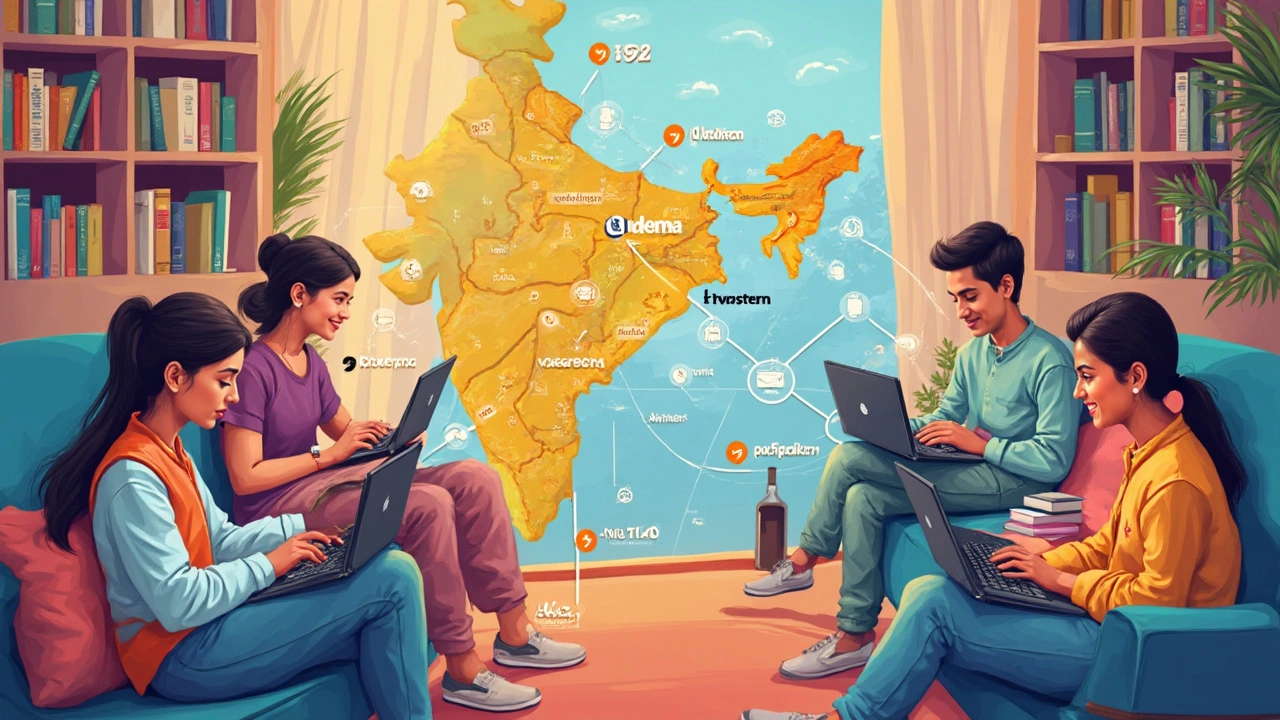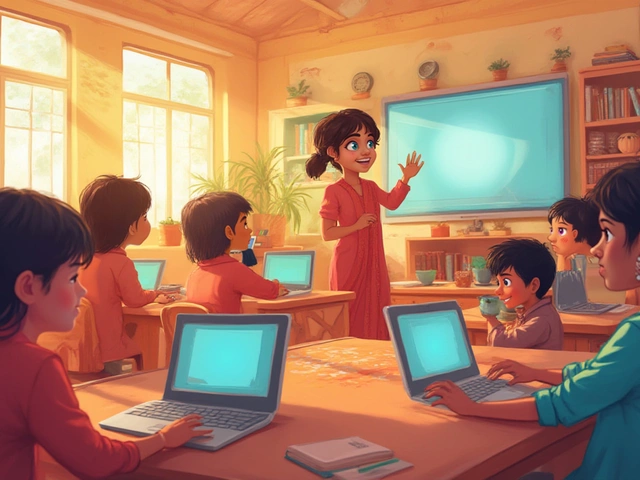Scrolling through search results for e-learning can feel like endless window shopping—there are just so many choices. You hear about sites like Coursera or Udemy all the time, but that's barely scratching the surface. Online education has exploded in the last few years, and new platforms are popping up every month. Some are huge, offering everything from coding to baking, while others zoom in on one skill, like creative writing or data analysis.
But what's the real number? Well, it's not a simple answer. Nobody can pin it down exactly, because things shift fast—some sites close, others merge, fresh ones launch. Still, industry trackers say there are easily over a thousand e-learning platforms worldwide. That doesn't even count the smaller, local ones or the big universities that run their own online courses. No matter what you want to learn, odds are there's a digital platform out there ready to teach it.
- E-Learning Platforms: What Are We Talking About?
- The Huge Variety: Counting the Players
- Top Global Names You Already Know
- Niche Platforms You Might Miss
- How to Pick the Right Platform
- Trends and What’s Next in E-Learning
E-Learning Platforms: What Are We Talking About?
When people say “e-learning platforms,” they usually mean websites or apps that let you learn stuff online, either for free or—you guessed it—by paying. These aren’t just places that give you the same old textbooks in PDF form. Modern e-learning sites offer video lessons, interactive quizzes, downloadable worksheets, and sometimes even live classes right from your laptop or phone.
The easiest way to explain an e-learning platform: it’s a digital classroom. But unlike school, you get to pick your schedule, your teacher, and even whether you show up in pajamas. Some of the biggest brands in e-learning platforms right now are Coursera, Udemy, edX, and Khan Academy, each one with its own flavor. Coursera, for example, teams up with top universities and companies to deliver degree programs and certifications. Udemy is more like a massive online marketplace, letting almost anyone share or buy a course. Meanwhile, Khan Academy focuses on school kids and offers everything for free, while edX is big on university-level stuff.
Here’s what these sites usually offer:
- Video lectures and tutorials
- Quizzes, assignments, and progress tracking
- Discussion forums and chat for connecting with other learners and instructors
- Certificates (some free, others paid), badges, or even real college credits
If you think e-learning only means big university courses, think again. There are platforms aimed at teaching languages, coding, cooking, photography, or even how to fix your bike. Whether you want to pick up a new hobby or boost your career, these platforms break down walls and make learning accessible. That’s the real magic—anyone, anywhere, can jump in, as long as there’s an internet connection.
The Huge Variety: Counting the Players
If you’ve ever wondered just how many e-learning platforms there really are, buckle up. According to HolonIQ’s 2024 Global EdTech report, there are now more than 1,400 unique branded e-learning platforms worldwide. That number shoots up to over 15,000 if you add all the small, homegrown, and niche players—including platforms tied to universities or companies that build their own in-house learning systems. And this is only counting structured platforms, not every YouTube channel or Discord server teaching something.
Platforms range from the giants like LinkedIn Learning, Skillshare, and edX, down to specialty ones such as Codecademy (coding), MasterClass (celebrity-led lessons), and Duolingo (language learning). If you’re thinking about K-12 learning, there’s Khan Academy and platforms like BYJU’S in India, which has over 150 million users alone.
Some platforms only offer courses for a fee, while others—like FutureLearn or Coursera—throw in free classes if you don’t need the certificate. Looking for something ultra-specific? Platforms like Treehouse focus only on tech skills, while Domestika is all about creativity and design.
"The number of e-learning services has more than doubled since 2019, with new platforms serving every niche imaginable." — HolonIQ, EdTech Market Update 2024
Here’s what makes this mix even crazier:
- Local and regional focus: Turkish, Brazilian, and Southeast Asian platforms are growing fast and are sometimes bigger than Western ones locally.
- Different models: Subscription, pay-per-course, corporate licensing, and even ad-supported free learning—there’s something for every budget.
- Blended and hybrid platforms: Some mix online with live tutors or even physical meetups.
What’s wild is that people used to think online learning was just big universities throwing lectures online. Now, whether you want university credits, a quick tutorial, or something to boost your career, there’s a platform made for it—or one launching next month. There’s no master list, but it’s clear: students, hobbyists, and professionals now have more choices than ever.
Top Global Names You Already Know
When people mention e-learning platforms, a few big names pop up almost everywhere. Some of them are so well-known that their logos are right up there with the biggest tech brands. If you've ever searched for an online course, you probably came across at least one or two of these sites.
Let's break down the ones you hear about most:
- Coursera: Famous for its partnerships with universities like Yale, Stanford, and Google. Coursera is packed with college-level courses and professional certificates. Fun fact: It has over 113 million users as of 2024.
- Udemy: Udemy pulls in experts from every area—yoga teachers, web developers, photographers, you name it. With over 210,000 courses and 57 million students, it's hard to beat for variety.
- edX: Founded by Harvard and MIT, edX is all about high-quality, academic courses. Many are free to audit, and the platform even offers full online degrees.
- Khan Academy: It mainly targets school kids, but lots of adults use it for brushing up on math and science. Everything’s free, and lessons are super easy to understand.
- LinkedIn Learning: Previously called Lynda.com, this one is all about career growth. The courses—focused on business, tech, and creative skills—connect seamlessly to your LinkedIn profile.
Each of these platforms works a little differently. Some charge monthly subscriptions, others sell individual courses, and sites like Khan Academy really are free. They use video lessons, quizzes, forums, and certificates to keep you learning and show off your progress.
It’s pretty wild—if you total up just these five platforms, you’re looking at hundreds of millions of users and thousands of courses. They’re popular for a reason: people trust them, employers recognize their certificates, and their courses get updated all the time. Chances are, if you want to pick a trusted place to learn something new, you’ll end up on one of these global e-learning giants.

Niche Platforms You Might Miss
Most people land on big sites first, but some of the best learning happens on niche platforms. These are the hidden gems. Instead of packing every possible subject under one roof, they go deep into a single area—perfect for folks who want more than general knowledge.
Ever heard of MasterClass? Instead of classroom-style courses, you get lessons from legit celebrities—think Gordon Ramsay for cooking or Serena Williams for tennis. It’s slick, not stuffy. Or try Brilliant.org, a spot just for math, science, and logic lovers. They focus on interactive problem-solving, so you actually do the work instead of just watching lessons roll by.
Language learners still use Duolingo, but if you want to get conversational fast, platforms like italki let you book conversations with real native speakers. For art and design, Domestika is blowing up lately—they have high-quality video courses from working professionals worldwide, all focused on creative fields. And for anyone chasing tech careers, platforms like DataCamp only offer hands-on courses in data science and analytics—super popular, especially as these skills are in demand.
- e-learning platforms focused on specific skills usually offer community forums, feedback from experts, and even mentoring, giving you a much more personal experience compared to the big platforms.
- Some of them, like Codecademy for coding, actually let you practice right in your browser, so you don’t waste time jumping between tools or installations.
The crazy thing? Niche platforms often see higher engagement. According to a 2024 report by EdTech Magazine, users on focused sites complete courses 35% more often than those on general platforms.
| Platform | Main Focus | Unique Feature |
|---|---|---|
| MasterClass | Arts & Personal Skills | Celebrity Instructors |
| Brilliant.org | Math & Science | Interactive Problem Solving |
| italki | Languages | Live Chats with Natives |
| Domestika | Design & Creativity | Project-Based Courses |
| DataCamp | Data Science | Browser Coding Labs |
If you get clear about what you want to learn, it’s usually smart to check these niche sites first. You’ll skip the crowds and get straight to the good stuff.
How to Pick the Right Platform
It’s easy to feel overwhelmed when faced with hundreds of e-learning platforms. But choosing the right one can really make or break your learning experience. So, how do you zero in on the best fit for you? Here’s what actually matters:
- Your Learning Goals: Are you trying to get a certificate that holds water for employers, or are you just picking up a new hobby? For work credentials, look at big names like Coursera, LinkedIn Learning, or Udacity because they partner with real universities and companies. For hobbies, Skillshare or MasterClass might be more your vibe.
- Course Quality: Always check if the course is made by industry pros or top schools. Reading reviews helps. On Udemy, for example, courses are rated by thousands, which makes it easier to spot the good stuff.
- Budget: Some platforms let you learn for free, especially places like edX and Khan Academy. Others charge monthly, like Skillshare, or sell courses one by one.
- Flexibility: Can you learn at your own pace, or is it a set class schedule? If you’re juggling a job or kids, self-paced works best.
- Features & Support: Does the platform offer mobile access, downloadable resources, or live help if you get stuck? If you need a good mix, platforms like Coursera and FutureLearn offer plenty of support.
No single platform rules them all. The best one for you will fit your goal, your lifestyle, and your wallet. Always test with a free trial or peek at a course preview before committing. Don’t be shy—most platforms want you to try before you buy.
Trends and What’s Next in E-Learning
E-learning isn’t sitting still—it’s racing ahead. If you’re wondering what’s shaking up the world of e-learning platforms, here’s what’s making big waves right now and what you might be seeing soon.
First, artificial intelligence is everywhere. Many platforms now use AI to give learners personalized recommendations, smart quizzes, and even help with homework grading. For example, Duolingo’s AI adapts language lessons based on what you struggle with. And on Coursera, you’ll see AI-generated practice questions popping up in the toughest spots of a lesson.
Another shift: microlearning. People want info in quick doses, not hour-long lectures. Platforms like Skillshare and MasterClass are breaking lessons into tiny chunks—think 5 to 15 minutes—because few have time or patience for marathon sessions.
And who can ignore mobile learning? Over 60% of users now access e-learning from their phones. That’s forced even the big players to redesign apps for speed and simplicity. No one wants to squint at tiny text or wait forever for videos to load.
If you like hands-on learning, you’ll love the surge in simulations and virtual reality. Medical students are actually practicing surgery in VR, and platforms teaching coding now let you write real code right in your browser—no downloads needed.
There’s also a move to make learning more social. Built-in forums, live group classes, and peer-to-peer feedback are showing up everywhere, pushing folks to connect instead of just going solo.
Here’s a look at some of the latest industry stats:
| Trend | Fact/Stat |
|---|---|
| Mobile Learning | 60%+ of e-learning happens on mobile devices (Statista, 2024) |
| AI in E-Learning | 65% of top platforms added AI-based features since 2022 (EdTech Digest, 2024) |
| Microlearning | Micro-lesson demand grew 25% year over year (Learning Industry Report, 2024) |
| VR/AR Use | Projected to hit $12B in e-learning by 2026 (Global Market Insights, 2024) |
Thinking ahead, experts expect even more custom courses—built just for you, not the crowd. Skills badges and digital certificates will count more with employers. And don’t be surprised when AI tutors pop up alongside your favorite teachers, ready to answer at any hour.
If you’re picking a new platform, keep an eye out for these trends. The best learning is getting faster, smarter, and way more flexible—letting you learn exactly the way you want, right from your phone or laptop.



